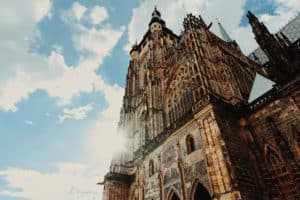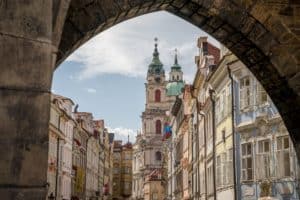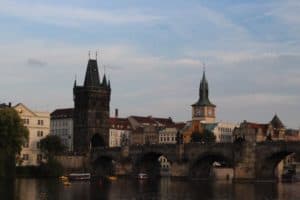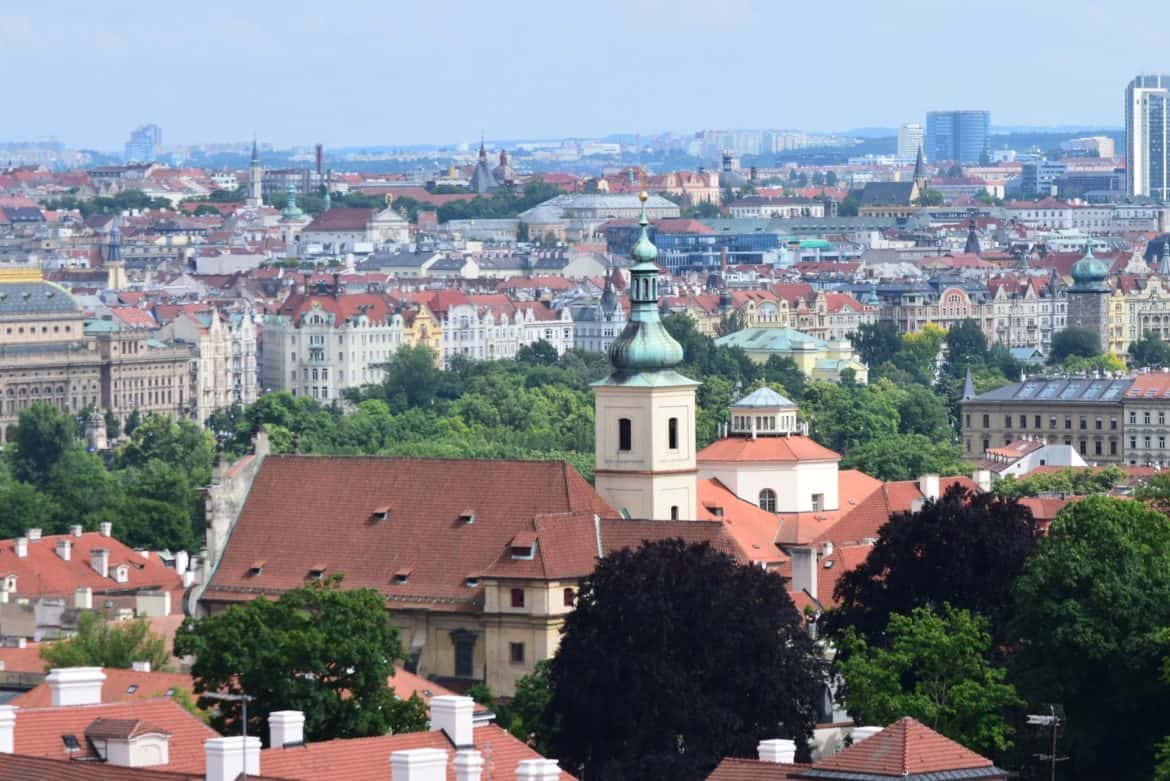The Eastern Europe is undoubtedly a tourist destination worth visiting. Some say it was the center of the world for a long time… and maybe that’s true. For many people, the countries in Eastern Europe are not the first destinations that come to mind when thinking about a trip to the Old Continent. However, their deep and rich histories make this region an unforgettable experience for travelers from all over the world.
In our mission to uncover the gastronomic secrets of the world, we cover three Eastern European countries in our Secret Food Tours: Hungary, Poland, and the Czech Republic.
In this blog post, we will delve into the area where our Czech tour takes place…
The Malá Strana District
The Malá Strana District is where past and present collide. The rhythm of modern life echoes through medieval lanes, bouncing off stalwart structures that date back hundreds of years. It’s like a greatest hits compilation of Prague’s history, offering a tangible link to the city’s storied past. And what better way to complement these narratives than with a food tour that weaves a captivating tale of its own?
Malá Strana District, or the Lesser Town, holds a hallowed place in the annals of Czech and European history. Established by King Ottokar II of Bohemia in 1257, it quickly developed into a political, economic, and cultural power center owing to its strategic location between the Prague Castle and the Vltava River. The aristocratic residences and noble estates that pepper Malá Strana’s landscape today stand as a testament to its prosperous past.
The remarkable architectural heritage of the Malá Strana District offers a tangible record of the area’s rich and complex history. Through the centuries, the district endured disastrous fires, foreign invasions, political upheavals, and time-induced wear and tear. Despite these challenges, Malá Strana triumphed to preserve its iconic landmarks such as St. Nicholas Church and Charles Bridge, as well as an unparalleled ensemble of Baroque, Renaissance, and Gothic buildings.
Origins and Early History
What we now know as the alluring Malá Strana District was, at one point in history, a pastoral haven sprawling with vineyards, gardens, and orchards. These were tended by the ruling Přemyslid dynasty, whose agricultural practices left a lingering imprint on the area’s topography and use of land.
However, the seeds of urbanization were sown in 1257 when King Ottokar II issued a royal decree. His invitation welcomed German settlers and members of the Czech nobility to inhabit and develop this prime district. Heeding the call, the area underwent a transformative shift from a pastoral panorama to a burgeoning town square, asserting itself as a vital political and cultural axis of the city.
Era of Transformation
The period between the 15th and 17th centuries served as a critical turning point in Malá Strana’s narrative. During this era, the district became a stage for significant urban overhaul, primarily triggered by calamitous fires that swept through the area in 1503 and 1541.
The silver lining of such predicaments lay in the opportunity for renewal and architectural evolution that they brought forth. Post-fire reconstruction catapulted Malá Strana into an era of architectural renaissance, absorbing and reflecting prevalent stylistic influences including Gothic, Renaissance, and Baroque styles.
Through the lens of architecture, the stages of Malá Strana’s transformation become exceptionally vivid – the soaring spires of Gothic style, the harmonious proportions of the Renaissance, and the dramatic grandeur of Baroque ornamentalism. Each era of reconstruction imbued the landscape with its distinct aesthetic nuances, collectively creating an architectural tapestry that narrates Prague’s historical trajectory.
Malá Strana’s Landmarks
Notable landmarks within Malá Strana District include:
Prague Castle: Synonymous with power and prestige, this ancient fortress has neen an epicenter of political and cultural events since the 9th century.

St. Nicholas Church: A Baroque masterpiece, its interior and acoustics make it among Europe’s most striking ecclesiastical structures.

Charles Bridge: Completed in 1402, this iconic Gothic stone bridge anchors Prague’s identity and fosters connections between the two banks of the Vltava River.

Cultural influences
Malá Strana’s cultural narrative encompasses:
German influences: German architects and craftsmen, such as Bonifaz Wolmut and Hans Tirol, left an indelible mark on Malá Strana, particularly during the Renaissance era.
Jewish heritage: The presence of a vibrant Jewish community from the late 13th century enriched the area’s cultural fabric.
Religious transformation: The Protestant Reformation in the 16th century and the subsequent Counter-Reformation and Catholic Revival contributed to the area’s shifting religious landscape.
Local Life and Culture
Malá Strana District’s allure lies in its ability to blend the past with the present, creating an atmosphere rich in heritage yet buzzing with contemporary life. Pastel-hued houses, historic pubs, and cozy cafes intermingle, offering a tapestry of sights, sounds, and scents. Vojan Gardens and Kampa Park provide serene retreats from the urban rhythm, while the Lennon Wall is a symbol of art, freedom, and resistance.
A crucible for artistic expression, the Malá Strana District has inspired and nurtured creative minds from various disciplines:
Music: Wolfgang Amadeus Mozart resided near the district while composing “Don Giovanni,” and Baroque composer Jan Dismas Zelenka spent much of his life in Malá Strana.
Literature: The district’s past residents include Franz Kafka and Czech writers Jaroslav Seifert, Vladislav Vančura, and Karel Capek.
Theater: Malá Strana’s theater scene has thrived over the centuries, with historic venues such as the Estates Theater and Divadlo Na zábradlí hosting memorable performances.
Our Prague Secret Food Tour
Now let’s dive into 3 of the culinary delights of our Malá Strana Food Tour!
Our Food Tour is more than just a sampling of dishes. It’s an immersive experience into the heart of Czech gastronomy. Anchored in the idyllic Malá Strana district, we unravel not just the unique flavors but the stories behind them. Here is a little spoiler of some of the food offerings featured on our tour:
Food Tour Spoiler #1 – Párek v rohlíku (Czech hot dog):
Párek v rohlíku, commonly known as a Czech hot dog, is a beloved street food that holds a significant place in Czech culture. Its history dates back to the late 19th century when Czech immigrants in the United States were exposed to the American hot dog. Upon their return to the Czech lands, they brought the concept of a sausage served in a roll (rohlík) back home. Since then, the Czechs have embraced this delicious and convenient snack.
Ingredients for párek v rohlíku typically include a smoked or boiled sausage made from a blend of pork, beef, and seasonings. The roll (rohlík) is a uniquely Czech bread, similar to a baguette but with a distinct taste and texture. It is often topped with mustard, ketchup, or a mix of both, and sometimes garnished with chopped onions.
Preparation method: The sausage is usually cooked through grilling or boiling, while the rohlík is baked until golden and crusty. The two components are then assembled, and condiments are added according to personal preference.
Relevance to Czech culture: Párek v rohlíku is not only a quick and tasty snack for Czechs on the go, but it also represents a blend of Czech culinary traditions with influences from other cultures. It has become a symbol of Czech street food, enjoyed at sports events, fairs, and outdoor gatherings, reflecting the Czechs’ love for simple yet satisfying meals.
Food Tour Spoiler #2 – Traditional Bohemian Soup:
Traditional Bohemian soups hold a special place in Czech cuisine, reflecting the nation’s deep-rooted culinary heritage. Czech soups are known for their hearty and comforting flavors, which have evolved over centuries.
Ingredients: The ingredients for traditional Bohemian soup may vary depending on the region and the season, but some common elements include potatoes, carrots, onions, celery, and various herbs. Meat, such as chicken, beef, or pork, is often added to enhance the flavor.
Preparation method: The preparation involves slow-cooking the ingredients together in a flavorful broth until they become tender and meld their flavors. Some popular varieties include potato soup (bramborová polévka), garlic soup (česnečka), and beef broth with liver dumplings (játrové knedlíčky).
Relevance to Czech culture: Soups are an integral part of Czech culture, served as the first course in many traditional meals. They are cherished for their ability to bring warmth and comfort, making them especially popular during the colder months. Czech families have passed down soup recipes through generations, preserving their culinary heritage.
Food Tour Spoiler #3 – Homemade sauerkraut Knedlo-vepro-zelo (dumplings-pork-cabbage):
Knedlo-vepro-zelo is a classic Czech dish that represents the country’s love for dumplings and hearty flavors. This dish is a perfect example of the Czechs’ skill in transforming simple ingredients into a delicious and satisfying meal.
Ingredients: The dish comprises three main components: knedlíky (dumplings), vepřové (pork), and zelí (sauerkraut). The dumplings are made from a mixture of bread, flour, milk, eggs, and yeast. The pork is seasoned and slow-cooked to tender perfection. Sauerkraut, which is fermented cabbage, adds a tangy and unique flavor to the dish.
Preparation method: The dumpling dough is prepared, rolled into balls, and then boiled until cooked. The pork is seasoned with traditional Czech spices and roasted or braised until it becomes succulent. The sauerkraut is heated and often combined with the pork to create a delicious and flavorful accompaniment.
Relevance to Czech culture: Knedlo-vepro-zelo has been a staple in Czech households for centuries, passed down from one generation to another. It represents the Czechs’ ingenuity in using simple ingredients to create a hearty and satisfying meal that brings family and friends together. The dish is often enjoyed during special occasions and family gatherings, making it an essential part of Czech culinary traditions.
And of course, there is much more, but we don’t want to give it all away on a silver platter!
And here, at the end, we have to ask: After all this insights are you ready to step back in time while tickling your taste buds? Prague’s historic Malá Strana beckons you to discover its unique architectural beauty and flavor-packed culinary secrets. Come join our food tour and create your own delicious memories in the heart of Prague. This isn’t just about food; it’s about celebrating culture, history, and the joy of discovery. Ready to embark on this gastronomic adventure? Pack your appetite and let’s go!
